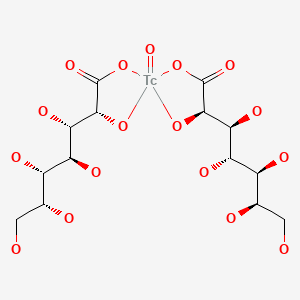Attribution Statement: LactMed is a registered trademark of the U.S. Department of Health and Human Services.
NCBI Bookshelf. A service of the National Library of Medicine, National Institutes of Health.
Drugs and Lactation Database (LactMed®) [Internet]. Bethesda (MD): National Institute of Child Health and Human Development; 2006-.
CASRN: 153546-52-2

Drug Levels and Effects
Summary of Use during Lactation
Information in this record refers to the use of technetium Tc 99m glucoheptonate (Tc 99m gluceptate) as a diagnostic agent. A US Nuclear Regulatory Commission subcommittee has recommended that nursing be discontinued for 24 hours after administration of all technetium Tc 99m diagnostic products to simplify guidance recommendations, although this time interval may be longer than necessary.[1] According to the International Commission On Radiological Protection, breastfeeding need not be interrupted after administration of technetium 99mTc glucoheptonate.[2] However, to follow the principle of keeping exposure "as low as reasonably achievable", some experts recommend nursing the infant just before administration of the radiopharmaceutical and interrupting breastfeeding for 3 to 6 hours after the dose, then expressing the milk completely once and discarding it. If the mother has expressed and saved milk prior to the examination, she can feed it to the infant during the period of nursing interruption.[3-5]
Mothers concerned about the level of radioactivity in their milk could ask to have it tested at a nuclear medicine facility at their hospital. When the radioactivity is at a safe level, they may resume breastfeeding. A method for measuring milk radioactivity and determining the time when a mother can safely resume breastfeeding has been published.[6]
For nursing mothers who work with Tc 99m substances in their workplace, there is no need to take any precautions other than those appropriate for general radiation protection.[7]
Drug Levels
Tc 99m is a gamma emitter with a principal photon energy of 140 keV and a physical half-life of 6.04 hours.[1] The effective half-life of Tc 99m gluceptate ranges from 3.6 to 4 hours.[6]
Effects in Breastfed Infants
Relevant published information was not found as of the revision date.
Effects on Lactation and Breastmilk
Relevant published information was not found as of the revision date.
References
- 1.
- Dilsizian V, Metter D, Palestro C, Zanzonico P. Advisory Committee on Medical Uses of Isotopes (ACMUI) Sub-Committee on Nursing Mother Guidelines for the Medical Administration of Radioactive Material. Final report submitted: January 31, 2019. 2019. https://www
.nrc.gov/docs /ML1903/ML19038A498.pdf - 2.
- Mattsson S, Johansson L, Leide Svegborn S, et al. Radiation dose to patients from radiopharmaceuticals: A compendium of current information related to frequently used substances. ICRP Publication 128. Annex D. Recommendations on breast-feeding interruptions. Ann ICRP 2015;44:319-21. [PubMed: 26069086]
- 3.
- Mountford PJ, Coakley AJ. A review of the secretion of radioactivity in human breast milk: Data, quantitative analysis and recommendations. Nucl Med Commun 1989;10:15-27. [PubMed: 2645546]
- 4.
- ARSAC notes for guidance: Good clinical practice in nuclear medicine. Notes for guidance on the clinical administration of radiopharmaceuticals and use of sealed radioactive sources. 2020. https://www
.gov.uk/government /publications /arsac-notes-for-guidance [PubMed: 10732169] - 5.
- Mitchell KB, Fleming MM, Anderson PO, Giesbrandt JG. ABM Clinical Protocol #30: Radiology and nuclear medicine studies in lactating women. Breastfeed Med 2019;14:290-4. [PubMed: 31107104]
- 6.
- Stabin MG, Breitz HB. Breast milk excretion of radiopharmaceuticals: Mechanisms, findings, and radiation dosimetry. J Nucl Med 2000;41:863-73. [PubMed: 10809203]
- 7.
- Almén A, Mattsson S. Radiological protection of foetuses and breast-fed children of occupationally exposed women in nuclear medicine - Challenges for hospitals. Phys Med 2017;43:172-7. [PubMed: 28882410]
Substance Identification
Substance Name
Technetium Tc 99m Glucoheptonate
CAS Registry Number
153546-52-2
Drug Class
Breast Feeding
Lactation
Milk, Human
Radiopharmaceuticals
Technetium Compounds
Disclaimer: Information presented in this database is not meant as a substitute for professional judgment. You should consult your healthcare provider for breastfeeding advice related to your particular situation. The U.S. government does not warrant or assume any liability or responsibility for the accuracy or completeness of the information on this Site.
- User and Medical Advice Disclaimer
- Drugs and Lactation Database (LactMed) - Record Format
- LactMed - Database Creation and Peer Review Process
- Fact Sheet. Drugs and Lactation Database (LactMed)
- Drugs and Lactation Database (LactMed) - Glossary
- LactMed Selected References
- Drugs and Lactation Database (LactMed) - About Dietary Supplements
- Breastfeeding Links
- PubChem SubstanceRelated PubChem Substances
- PubMedLinks to PubMed
- Review Technetium Tc 99m Glucoheptonate.[Drugs and Lactation Database (...]Review Technetium Tc 99m Glucoheptonate.. Drugs and Lactation Database (LactMed®). 2006
- Review Technetium Tc 99m Disofenin.[Drugs and Lactation Database (...]Review Technetium Tc 99m Disofenin.. Drugs and Lactation Database (LactMed®). 2006
- Review Technetium Tc 99m Gluconate.[Drugs and Lactation Database (...]Review Technetium Tc 99m Gluconate.. Drugs and Lactation Database (LactMed®). 2006
- Review Technetium Tc 99m Medronate.[Drugs and Lactation Database (...]Review Technetium Tc 99m Medronate.. Drugs and Lactation Database (LactMed®). 2006
- Review Technetium Tc 99m Tetrofosmin.[Drugs and Lactation Database (...]Review Technetium Tc 99m Tetrofosmin.. Drugs and Lactation Database (LactMed®). 2006
- Technetium Tc 99m Glucoheptonate - Drugs and Lactation Database (LactMed®)Technetium Tc 99m Glucoheptonate - Drugs and Lactation Database (LactMed®)
- Tssr137245 AND (alive[prop]) (0)Gene
- Gm30101 predicted gene, 30101 [Mus musculus]Gm30101 predicted gene, 30101 [Mus musculus]Gene ID:102631879Gene
- Gm30101 AND (alive[prop]) (1)Gene
Your browsing activity is empty.
Activity recording is turned off.
See more...
